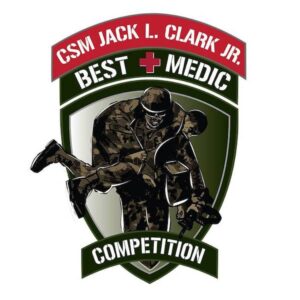
Story by Paul Lagasse
Medical Research and Development Command
FORT DETRICK, Md. – Staff Sgt. Rodrigo Flores and Sgt. Juan Garcia say it was the prospect of being able to team with each other that inspired them to participate in the 2024 Command Sgt. Maj. Jack L. Clark, Jr. U.S. Army Best Medic Competition at Fort Liberty, North Carolina, earlier this month.
And although they did not bring the trophy home with them when they returned to the U.S. Army Medical Research and Development Command’s Institute of Environmental Medicine in Natick, Massachusetts, Flores and Garcia said it was their experience working together that made it possible for them to successfully finish the notoriously demanding contest of skill and endurance.
“When I arrived at USARIEM about a year ago, one of the first things I heard was that Sgt. Garcia, had just recently done Best Medic,” recalls Flores, the NCO In Charge at USARIEM’s Office of Medical Support and Oversight, and Garcia’s supervisor. “I’ve done Best Medic before in the past, and I thought it would be awesome if we could go as a team, versus getting paired up with somebody from a different brigade who you’ve never met. That was probably my biggest driver – we worked together, so I figured it should go smoothly.”
Garcia, a health care specialist at OMSO who was also on the MRDC team at last year’s Army Best Medic Competition, felt the same way about Flores.
“After last year I immediately wanted to go again, but when I met Staff Sgt. Flores and realized how very highly motivated he is, and how he had also competed in Best Medics before, I knew I wanted to compete with him as well,” says Garcia.
The centerpiece of the annual competition, which took place from March 4-8, is a three-day test of participants’ medical skills and physical fitness. Participants must compete in 17 events ranging from the standard Army Combat Fitness Test and Army Combat Water Survival Test to activities developed specifically for the contest, including a written test, an obstacle course, a land navigation exercise, medical response scenarios, weapons qualifications and a grueling 16-mile ruck march.
MRDC Command Sgt. Maj. Kyle Brunell says that the Best Medic competitions provide valuable training in wartime skills for Army medics, particularly for those assigned to organizations like MRDC that do not routinely deploy on forward operations. And because the competitions are open to all medical military occupational specialties, organizations that do not have many combat medical specialists – such as MRDC – can still compete on equal terms against Army units that do.
Brunell spoke with Flores and Garcia after they returned from the competition and said he was impressed not only by their effort, but by their commitment to learn from the experience.
“I’m proud of how far they came,” says Brunell. “When I look at their faces, I don’t see anger, I don’t see frustration. I see determination to do better next time. What more can you ask for?”
Looking back at their performance, Flores and Garcia agree that the ruck march was their most challenging event, but not so much because of the march itself.
“I think what got us was that the day prior, we had a lot of physical events and not a lot of sleep the night before,” says Garcia. “We didn’t think it would fatigue us as much as it did, but that resulted in us just not performing as well as we usually do in the ruck.”
Both Flores and Garcia excelled at the weapons qualifications, in part due to the practice they had gotten in since participating in the 2023 Medical Readiness Command-East and U.S. Medical Research and Development Command Best Medic Competition at Fort Eisenhower, Georgia, last year.
“We’re both pretty good shots, but when we competed in November, I don’t know what it was, but we just weren’t feeling it and our quals weren’t as good as they normally are,” says Garcia. “That was one of our biggest worries. But when we showed up at Fort Liberty, we both shot phenomenally. We couldn’t be happier with our scores.”
Perhaps surprisingly for an event filled with such constant activity, the Army Best Medic Competition affords participants with plenty of opportunities for meeting old friends and making valuable new career connections.
“It’s honestly a huge networking opportunity,” says Flores. “You meet specialists, lieutenants, captains, sergeants first class. I saw old platoon sergeants who I served with five or six years ago, people I knew from my time in Korea. I couldn’t turn the corner without starting a conversation with somebody. They might not know each other, but I could introduce people and they could introduce me.”
Both men have the same advice for aspiring competitors.
“Whatever effort you put into it is what you get out of it,” says Garcia. “Nothing they tell you to do there is impossible. It’s up to you to get out there and practice.”
“We’ll just take all of this as a lesson to improve next year,” he adds.
Flores says he hopes to represent USARIEM and MRDC again at next year’s Army Best Medic Competition. Garcia plans to compete again as well, but he is scheduled for a permanent change of station later this year.
But while they may not end up competing as a team next year, it’s certain Flores and Garcia will recognize each other when they do meet up again.